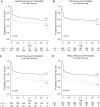Epidemiology, Mechanical Power, and 3-Year Outcomes in Acute Respiratory Distress Syndrome Patients Using Standardized Screening. An Observational Cohort Study
- PMID: 31247145
- PMCID: PMC6812172
- DOI: 10.1513/AnnalsATS.201812-910OC
Epidemiology, Mechanical Power, and 3-Year Outcomes in Acute Respiratory Distress Syndrome Patients Using Standardized Screening. An Observational Cohort Study
Abstract
Rationale: Limited data on the epidemiology of acute respiratory distress syndrome (ARDS) using a standardized screening program exist.Objectives: To describe the population-based incidence of hypoxemic respiratory failure and ARDS using a prospective standardized screening protocol; and to describe the mechanical ventilation practice and the mechanical power and examine their association with 28-day and 3-year survival outcomes.Methods: A prospective standardized screening program for ARDS, as a quality improvement initiative, was initiated at four adult intensive care units over a 27-month period. An ancillary analysis of this observational cohort was performed. Patients requiring mechanical ventilation for ≥24 hours underwent prospective and consecutive screening using standardized ventilator settings. Patient physiological data and outcomes were collected prospectively through an electronic clinical-information system and retrospectively analyzed to apply Berlin criteria.Results: Screened were 7,944 patients, among which 986 (12.4%) had hypoxemic respiratory failure (arterial oxygen tension to inspired fraction of oxygen ratio ≤300), and 731 (9.2%) met criteria for ARDS. Age-adjusted incidence of hypoxemic respiratory failure and ARDS were 37.7 and 27.6 cases per 100,000 person-years, respectively. Patients sustaining the diagnosis of ARDS had a hospital mortality of 26.5% for mild, 31.8% for moderate, and 60.0% for severe ARDS and a 3-year mortality of 43.5% for mild, 46.9% for moderate, and 71.1% for severe ARDS. Mechanical power >22 J/min was associated with increased 28-day hospital and 3-year mortality. Determinants of mechanical power associated with lower 28-day hospital and 3-year survival included plateau pressure >30 cm H2O and driving pressure >15 cm H2O, but not tidal volumes >8 ml/kg of predicted body weight.Conclusions: Using standardized screening, a large proportion of patients with hypoxemic respiratory failure met criteria for ARDS. Increasing ARDS severity was associated with increased 28-day hospital and 3-year mortality. Increased mechanical power was associated with increased mortality. Potentially modifiable determinants of mechanical power associated with lower survival included plateau pressure and driving pressure.
Keywords: adult; mechanical ventilation; respiratory distress syndrome.
Figures


Comment in
-
Beyond Tidal Volume in Acute Respiratory Distress Syndrome: Semiautomated Screening and Novel Ventilator Concepts.Ann Am Thorac Soc. 2019 Oct;16(10):1238-1240. doi: 10.1513/AnnalsATS.201906-488ED. Ann Am Thorac Soc. 2019. PMID: 31573340 No abstract available.
References
-
- Thompson BT, Chambers RC, Liu KD. Acute respiratory distress syndrome. N Engl J Med. 2017;377:562–572. - PubMed
-
- Bellani G, Laffey JG, Pham T, Fan E, Brochard L, Esteban A, et al. LUNG SAFE Investigators; ESICM Trials Group. Epidemiology, patterns of care, and mortality for patients with acute respiratory distress syndrome in intensive care units in 50 countries. JAMA. 2016;315:788–800. - PubMed
-
- Ranieri VM, Rubenfeld GD, Thompson BT, Ferguson ND, Caldwell E, Fan E, et al. ARDS Definition Task Force. Acute respiratory distress syndrome: the Berlin definition. JAMA. 2012;307:2526–2533. - PubMed
-
- Máca J, Jor O, Holub M, Sklienka P, Burša F, Burda M, et al. Past and present ARDS mortality rates: a systematic review. Respir Care. 2017;62:113–122. - PubMed
Publication types
MeSH terms
LinkOut - more resources
Full Text Sources
Miscellaneous

